The Intel Core i3-7350K (60W) Review: Almost a Core i7-2600K
by Ian Cutress on February 3, 2017 8:00 AM EST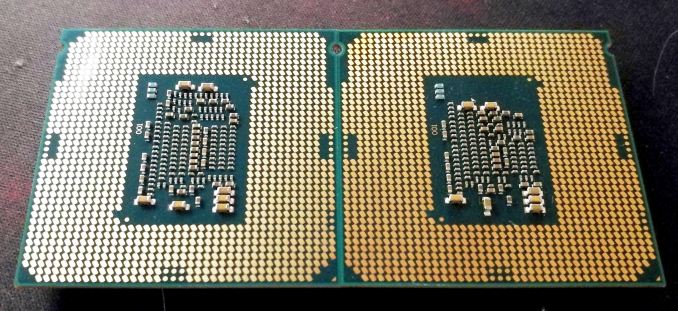
For some intrepid enthusiasts, this is the chip from Intel we’ve been waiting for. I foolishly predicted that Intel would never create an overclockable Core i3, because it had the potential to drive sales away from high-margin products. But here we are, Core i3-7350K in hand, and the ability to drive almost 5.0 GHz without too much trouble. This raises a couple of questions: just how close is it to the cheapest Core i5-7400 out of the box, which is only a few dollars more, and how close is it to the Core i7-2600K, a favorite chip among enthusiasts who have not yet upgraded.
Slap Me On The Wrist
For the previous generation of Intel products, we reviewed the Core i3-6100TE. This was a low-powered Core i3, but it was paired with the SuperMicro C7H170-M, a motherboard that enabled adjustment of the base frequency from 100 MHz to 130 MHz and up. This was the first chance in a number of generations to test what would essentially be an overclockable Core i3 product. There were many teething issues, as overclocking via the base frequency is less stable than by the multiplier, plus the motherboard options were not the easiest to work with.
However the final conclusion was that the Core i3 parts, while having two cores and hyperthreading, have difficulty keeping up with the Core i5 in tasks where having actual cores matter. For gaming, especially 1080p or Full-HD gaming, there was a small difference in favor of the Core i5, and the indication that with DX12 enabling multi-core gaming in a nicer way before, a gap would likely emerge over time (but mainly for high-end games for now). As a result, we postulated that Intel would never release a Core i3-K product: doing so would potentially drive sales away from the i5-K, as here is a part that could perform just as well for $60-$70 less, which users would have in pocket to upgrade a graphics card instead.
Can Die Size Account for the Difference?
Intel, from the outside, seems very margin driven: keeping those numbers above 60-65% in every department seems to be key to progress. As a result certain projects come and go, and others with potential have a small grace period but the bottom line is performance and strategy. One could argue that potentially offering an easy route for users to migrate down from a Core i5-K to a Core i3-K could affect that bottom line: users are paying $60 less per unit, and that’s a $60 loss per sale. This is one way of looking at it – another is considering that the Core i3-K parts are dual-core by design, and cheaper to make.
Disclaimer: The data for 2+2/4+2 Kaby Lake and Skylake for the following analysis were derived from high quality images of each die, and thus subject to error.
| CPU Die Size Comparison Numbers in table are to nearest degree of known accuracy Data from Intel or Trusted Sources (Chipworks/PCWatch) |
||||||
| CPU | Year | Process Node |
Die Size 2C or 2+2 |
Die Size 4C or 4+2 |
Die Size 4+3/e (no eDRAM) |
Die Size (other) |
| Intel Kaby Lake | 2017 | 14+nm | 98.68 | 126.15 | - | |
| Intel Skylake | 2015 | 14nm | 98.57 | 122.40 | 234 | - |
| Intel Broadwell | 2014 | 14nm | 82 | *** | 241.50 | 133 (2+3) 246.24 (10C) 306.18 (15C) 456.12 (24C) |
| Intel Haswell | 2013 | 22nm | 130 | 177 | 264 | 181 (2+3) 355.52 (8C) 492 (12C) 662 (18C) |
| Intel Ivy Bridge | 2012 | 22nm | 118.09 | 159.82 | - | 256.5 (6C) 341 (10C) 541 (15C) |
| Intel Sandy Bridge | 2011 | 32nm | 149 | 216 | - | 435 (8C) |
| Intel Westmere (GPU on 45nm) |
2009 | 32nm | 81 (Core) 195* (+GPU) |
276** | - | 248 (6C) 513 (10C) |
| Intel Nehalem | 2008 | 45nm | - | 263 | - | 296 (HEDT) 684 (8C) |
| Intel Yorkfield | 2007 | 45nm | 107 | 220 | - | - |
| Intel Kentsfield | 2007 | 65nm | - | 280 | - | - |
| Intel Conroe | 2006 | 65nm | 145 | - | - | - |
Italicised numbers are calculated from images and represent more of a 'peak' die size. Data taken from delidded images varied wildly, from 105mm2 to 130mm2 for the 4+2, so should be taken under caution.
* Dual Core Westmere CPUs had a IGP built on 45nm
** Quad Core Westmere designs with IGP didn't exist, so this is an estimate of what it would have been
*** Broadwell 4+2 designs don't seem to exist. The two mobile parts (we don't have access to) that fit this description are likely to be cut down 4+3e parts.
Taking data from available images on delidding the dual core parts and quad core parts, it’s clear that the new generation of Kaby Lake processors are physically smaller than Skylake. But the difference between the Core i5/i7 core design (known as 4+2) and the Core i3 design (known as 2+2) isn’t that much. With a die size of 126.15 mm2 for the quad core and 98.68 mm2 for the dual core, the die sizes of the two chips are relatively close, with a difference of just 27.47 mm2. This makes the dual core design 78% of the quad core size. If costs scaled linearly with die size, then die size difference between the two (22%) equates to $52.75 of the cost of the i5-7600K list price. This is similar to the list price difference between the two chips as a whole.
As we have this data for the first time, it is interesting to see that Intel’s new method of ‘Process-Architecture-Optimization’ rather than Tick-Tock, is yielding results. The Skylake 4+2 die size is similar from 122 mm2 to 126 mm2, and goes in line with the fact that Intel has officially stated that one of the key features of the new 14+ process is that the transistors are more ‘relaxed’ and there’s no decrease in density. Exactly what that means is likely under wraps for all but Intel (or Chipworks). But the difference between Kaby Lake 4+2 and 2+2 also means that we can get a rough number for the die area required for two cores.
In this case, two Kaby Lake cores plus L3 cache (plus periphery required for another two cores) are approximately 27.47 mm2. This makes the two cores in the dual core design approximately (given sufficient error margin) 27.8 % of the die. Doubling the die size for the four core version means that the CPU cores take up ~43% of the design. It's worth noting that using Intel's official die shot of the quad-core above puts the core area at around the 33-37% mark, depending on how you count the interconnect. The GPU area is almost identical (within 1%) of the core area as well. Our numbers here are calculated from delidded CPUs rather than official numbers, as Intel sporadically gives out such numbers these days (it depends which department is making the announcement, oddly) which makes our results more of an upper limit which is important to consider.
Because of the image above, we could arguably call the GT2 graphics inside the quad core design equal in size to the CPU cores (which seems plausable) at 54.94 mm2, then using the full dize size measurement above, it leaves 16.27 mm2 for the memory controller, system agent, and other requirements. If we do the math back into the dual core design with the same graphics core, we get 16.27 mm2 for the memory controller and other requirements as well.
| Kaby Lake Comparison | |||||
| CPU | Die Size | Cores | Core Area | GT2 Area | IMC + other |
| Intel Kaby Lake-S 4+2 | 126.15 | 4 | 54.94 | 54.94 | 16.27 |
| Intel Kaby Lake-S 2+2 | 98.68 | 2 | 27.47 | 54.94 | 16.27 |
For clarity, numbers in bold are measured; italics are estimates, and others are calculated.
So if the difference in die size can account for the price difference and won’t affect margins, what’s the bottom line here? Ultimately $60-70 per sale lost is a drop in revenue. However, it also depends on yields, and how the different CPUs are being binned. That information we won’t ever have. What we do know is that the Core i3-7350K is coming onto shelves at the end of January/beginning of February, rather than with the rest of the Kaby Lake CPUs in early January. So perhaps, ultimately, the effect of offering a Core i3-K in this case is minimal to Intel’s bottom line.
But Where Does the Core i3-7350K Fit In?
Intel's 7th Generation of Core CPUs, which often goes by its internal code name 'Kaby Lake', stretches from 91W on the mainstream desktop down to 4.5W for notebook processors, all using the same underlying technology in different core and integrated graphics configurations. The i7-7700K is the top part of this processor family, featuring four cores with hyperthreading, and we move down through the Core i5 and Core i3 parts. This time there are three overclocking processors, with the new one being the Core i3-7350K.
| Intel Kaby Lake S SKUs | |||||||
| Cores/ Threads |
Base/ Turbo |
IGP | L3 | eDRAM | TDP | Cost OEM |
|
| i7-7700K | 4/8 | 4.2/4.5 | HD 630 | 8 MB | - | 91 W | $339 |
| i7-7700 | 4/8 | 3.6/4.2 | HD 630 | 8 MB | - | 65 W | $303 |
| i7-7700T | 4/8 | 2.9/3.8 | HD 630 | 8 MB | - | 35 W | $303 |
| i5-7600K | 4/4 | 3.8/4.2 | HD 630 | 6 MB | - | 91 W | $242 |
| i5-7600 | 4/4 | 3.5/4.1 | HD 630 | 6 MB | - | 65 W | $213 |
| i5-7600T | 4/4 | 2.8/3.7 | HD 630 | 6 MB | - | 35 W | $213 |
| i5-7500 | 4/4 | 3.4/3.8 | HD 630 | 6 MB | - | 65 W | $192 |
| i5-7500T | 4/4 | 2.7/3.3 | HD 630 | 6 MB | - | 35 W | $192 |
| i5-7400 | 4/4 | 3.0/3.5 | HD 630 | 6 MB | - | 65 W | $182 |
| i5-7400T | 4/4 | 2.4/3.0 | HD 630 | 6 MB | - | 35 W | $182 |
| i3-7350K | 2/4 | 4.2 | HD 630 | 4 MB | - | 60 W | $168 |
| i3-7320 | 2/4 | 4.1 | HD 630 | 4 MB | - | 51 W | $149 |
| i3-7300 | 2/4 | 4.0 | HD 630 | 4 MB | - | 51 W | $138 |
| i3-7300T | 2/4 | 3.5 | HD 630 | 4 MB | - | 35 W | $138 |
| i3-7100 | 2/4 | 3.9 | HD 630 | 3 MB | - | 51 W | $117 |
| i3-7100T | 2/4 | 3.4 | HD 630 | 3 MB | - | 35 W | $117 |
| G4620 | 2/4 | 3.7 | HD 630 | 3 MB | - | 51 W | $86 |
| G4600 | 2/4 | 3.6 | HD 630 | 3 MB | - | 51 W | $75 |
| G4600T | 2/4 | 3.0 | HD 630 | 3 MB | - | 35 W | $75 |
| G4560 | 2/4 | 3.5 | HD 610 | 3 MB | - | 54 W | $64 |
| G4560T | 2/4 | 2.9 | HD 610 | 3 MB | - | 35 W | $64 |
| G3950 | 2/2 | 3.0 | HD 610 | 2 MB | - | 51 W | $52 |
| G3930 | 2/2 | 2.9 | HD 610 | 2 MB | - | 51 W | $42 |
| G3930T | 2/2 | 2.7 | HD 610 | 2 MB | - | 35 W | $42 |
The Core i3-7350K is the odd member of the stack. It sits as the only processor with a TDP of 60W, and is priced very close to the Core i5-7400/7400T. The comparison between this two (we were able to run limited tests on the i5-7400) will be a key aspect to this review given the pricing – will an extra $14 for two more cores offset the fact that the Core i3-7350K has a super high base frequency? Having 4.20 GHz as the frequency of the Core i3-7350K is interesting: as a Core i3, it has no turbo mode per-se, and it operates either in a low power mode (800 MHz or so) when idle or at full throttle when needed. This has some advantages over a turbo mode by having peak power being the only consideration, especially when combined with Windows 10 and using Intel’s Speed Shift technology to ramp up to the top speed quickly.
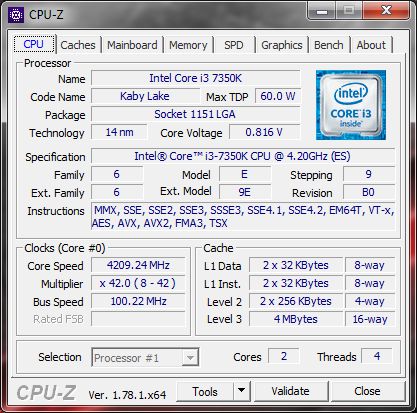
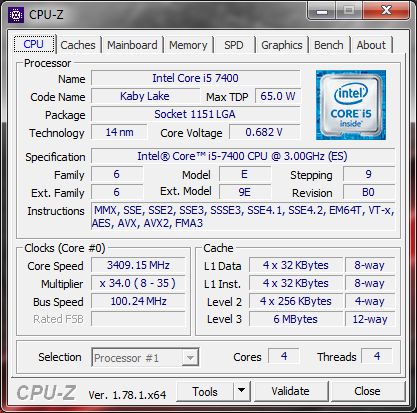
Intel Core i3-7350K vs Core i5-7400
Aside from the physical cores, the Core i3-7350K has less cache than the Core i5-7400, which is something to note.
One other pertinent comparison I want to make in this review is with the perennial favorite of DIY system builders for the last seven years or so: the Core i7-2600K. This is the high-end processor from the Sandy Bridge family that is known for being a good overclocker and a part which a lot of users are still on due to the lack of distinct performance improvements over the recent Intel microarchitectures. For most users still on these parts, the upgrade to a newer platform does not offer a substantial enough performance uptick to validate the outlay. However, at one point, there is going to be a Core i3 performance CPU that matches the Core i7-2600K. I want to find out if that time is now, or how far it might be away.

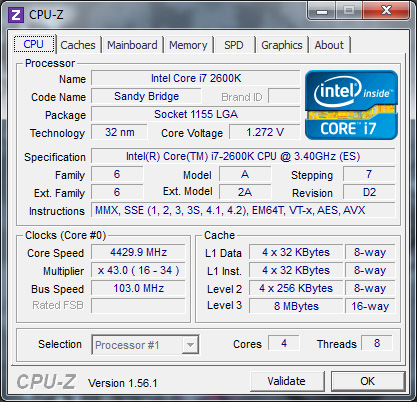
Intel Core i3-7350K vs Core i7-2600K (overclocked)
| Kaby Lake i3 vs Sandy Bridge i7 Comparison Launch Pricing |
|||||||||
| CPU | Year | Cores Threads |
Freq | Turbo | L3 | IGP | DRAM | TDP | Price |
| Core i3-7350K | 2017 | 2/4 | 4.2 | - | 4MB | HD 630 | DDR4-2400 | 60W | $168 |
| Core i7-2600K | 2011 | 4/8 | 3.4 | 3.8 | 8MB | HD 3000 | DDR3-1333 | 95W | $317 |
In simple numbers, the Core i7-2600K has a base frequency of 3.40 GHz and has a turbo up to 3.8 GHz. The Core i3-7350K is at 4.2 GHz, giving it both a frequency advantage and 35%+ advantage in instructions per clock (IPC) by virtue of being so many generations ahead. Aside from the L3 cache difference, and the move from DDR3 to DDR4, is there a sufficient frequency and IPC increase for the Core i3 to match the golden processor of yesteryear? This review will solve that question.
More about Kaby Lake
For readers that want a more in-depth take on Kaby Lake as a platform, we have a dedicated article full of information for you. We also have other articles in our Kaby Lake bonanza.
Other articles include:
Intel Launches 7th Generation Kaby Lake (Overview and Core Improvements)
The Intel Core i7-7700K Review: The New Out-of-the-box Performance Champion
The Intel Core i5-7600K Review: The More Amenable Mainstream Performer
The Intel Core i3-7350K Review: When a Core i3 Nearly Matches the Core i7-2600K (This Review)
Still to come
Calculating Generational IPC Changes from Sandy Bridge to Kaby Lake
Intel Core i7-7700K, i5-7600K and i3-7350K Overclocking: Hitting 5.0 GHz on AIR
Intel Launches 200-Series Chipset Breakdown: Z270, H270, B250, Q250, C232
Intel Z270 Motherboard Preview: A Quick Look at 80+ Motherboards


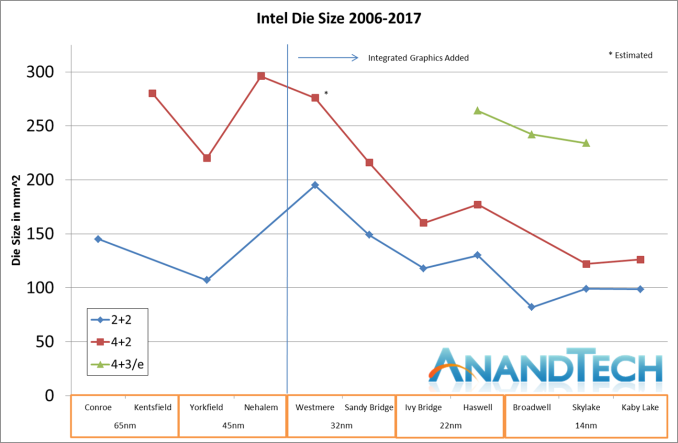
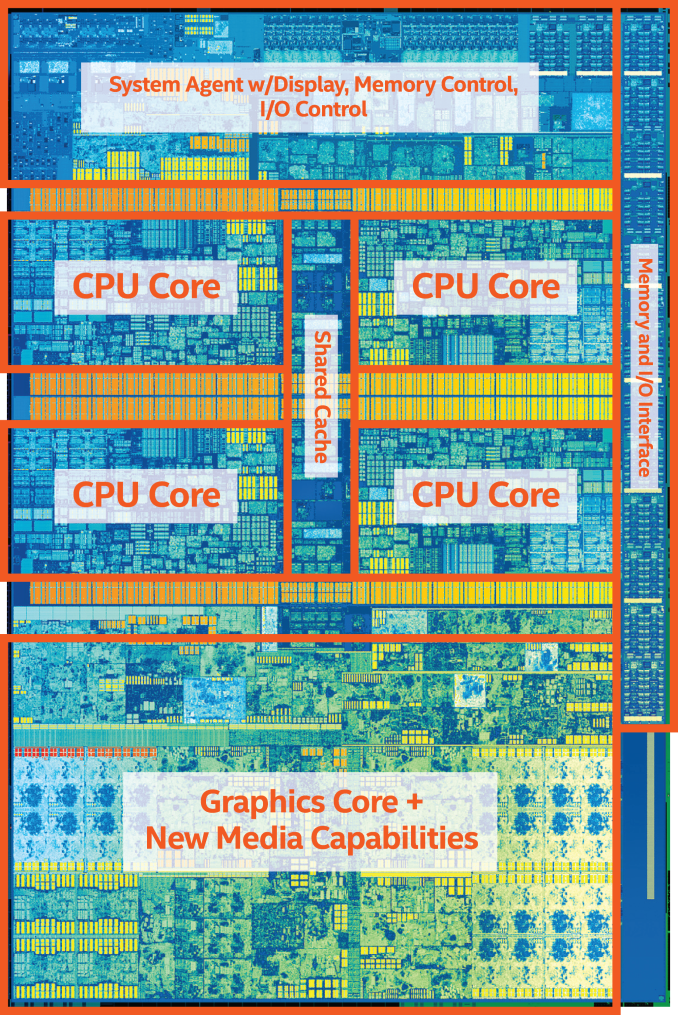








186 Comments
View All Comments
CaedenV - Friday, February 3, 2017 - link
Seems to me you only hit the CPU wall when dealing with multiple GPUs. For most games, with a single GPU, and i3 is plenty. Considering an i3 does not have enough PCIe lanes to support multiple GPUs this is a rather moot point.Aerodrifting - Saturday, February 4, 2017 - link
Like I said, You don't play any CPU demanding games so you have no right to make those ridiculous comments. Take battlefield 1 for example, Good luck in a 64 player map with i3.Michael Bay - Saturday, February 4, 2017 - link
>plays bf1>blabs about rights
You`re like a perfect example.
Aerodrifting - Saturday, February 4, 2017 - link
Nice trolling, loser.I am simply making a point: There are tons of games can bottleneck i3, Battlefield 1 is just one example, Stop lying to others "i3 can game just fine like i7 etc" it's very misleading and misinformed.
fanofanand - Sunday, February 5, 2017 - link
Considering the length of time Dr Cutress has been reviewing CPUs and gaming, any notion that he is not fit to be reviewing gaming CPUs is absurd.Aerodrifting - Sunday, February 5, 2017 - link
The notion of someone who is good at theorycraft reviews must be an expert at knowing gaming PC is absurd. 1 min of benchmark run in single player mode suddenly makes you an expert at gaming computer? Give me a break.BrokenCrayons - Thursday, February 9, 2017 - link
If you doubt the validity of the claims made in these articles in spite of the years of experience the writers have AND the supporting evidence of their work, then its rather odd you'd read any of these reviews at all. We can infer from your responses that you feel insecure about your purchase decisions, feel compelled to defend them aggressively, and that you're dismissing the evidence at hand even though you personally find it useful so you can justify the defensiveness -- more to yourself than others here because honestly, why should the opinions ruffle your feathers if there's genuinely no doubt in your mind that you feel you're as correct as you claim?Aerodrifting - Saturday, February 11, 2017 - link
Nice job coming up with such rhetoric yet no concrete evidence in your argument. I do NOT DOUBT the validity of the claims, I KNOW they are WRONG for a fact. Your reviewers do reviews for the sake of results from incomplete tests and benchmarks that can not represent real life results, Therefore the conclusion is wrong. I have been playing video games and playing around with hardware when you guys were playing with sand, Before this website is even established, Yet you want to talk about "years of experience"? I am not defending anything, I am simply pointing out you are wrong and you are misleading people, You are just butthurt because finally someone is having a different opinion and they are actually right.You want evidence? Let's save the rhetoric and go straight to facts, There are games that can severely bottleneck i3 or even i5, Battlefield is just one of them. Doesn't matter what video card you use, Join a 64 player game and you can see your CPU usage go over 90% and game starts stuttering on i3 / i5.
Ratman6161 - Friday, February 3, 2017 - link
"there will be a time where a Core i3 based CPU will match the performance of the older Core i7-2600K"Maybe, but not today! I'm still patting myself on the back for my purchase of the i7-2600K back in the spring of 2011. My first computer ran an 8088 and for every computer I owned weather off the shelf or self built from then until 2011 left me constantly on the upgrade treadmill looking for more speed . But with the 2600K I finally hit good enough (other than adding more RAM and replacing spinning disks with SSD's along the way). While its fun to read about the new stuff I don't really see myself upgrading again until either the CPU or (more likely) the motherboard give out.
CaedenV - Friday, February 3, 2017 - link
Yep! I have upgraded the ram several times, the GPU a few times, and moved from HDD to SSD, all of which have kept my 2600 very happy.What is going to get me to change over is going to be the motherboard level improvements. I cant get a much faster GPU without hitting a PCIe2 bottleneck. NVMe, while impractical (real world tests show little to no improvement), has me drooling for an upgrade. 4-10gig Ethernet is going to be more and more popular going forward. DDR4 is finally maturing to a point where it is actually better than DDR3. All new devices run USB-C, and my piddly 4 USB3 ports can't do them all, and certainly not at full speed.
It is literally everything around the CPU that is slowly making me want to upgrade, not the CPU itself. But even these improvements need another year or two to bake before I am really thinking about an upgrade. I am just unfortunately very happy with what I have, and I have one more GPU upgrade (looking forward to something like a GTX1170) before I will really need a new system.
Who knows, this might be my last 'real' PC. In a few years it may make more sense to have a central gaming server that runs all the games, and then stream them to an end-user PC that is no more powerful than a cell phone.... or just dock my cell phone.